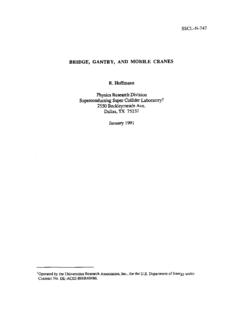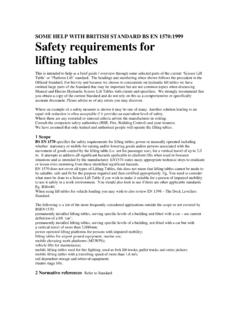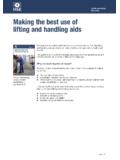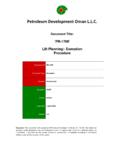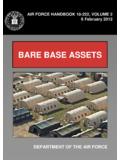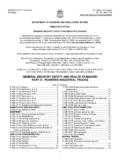Transcription of Construction Plant-hire Association Crane Interest …
1 Construction Plant-hire Association Crane Interest Group mobile Crane Technical Information Note TIN 101 The Effect of Wind on mobile Cranes In-service This Technical Information Note applies to both wheel and crawler mounted mobile cranes and provides mobile Crane users and operators with additional information on the effects of wind on mobile cranes, which will assist in the planning and safe execution of lifting operations. The wind forces exerted on both a mobile Crane and the load suspended from it, may well be quite large and affect both the strength and stability of the Crane , and safe handling of the load. It is not always appreciated that these forces are due to wind pressure, not wind speed, and that wind pressure varies as the square of the wind speed.
2 Consequently if the wind speed doubles, the wind pressure increases by a factor of four times. This means that a small increase of wind speed can have a significant effect on the safe operation of the mobile Crane . The mobile Crane s duty charts will specify the maximum wind speed at which the mobile Crane must be taken out of service. This value will vary with the specific make and model of Crane and also the duty on which it is rigged, but normally has a maximum value of 31 mph (14 m/s, 50kph) and is frequently well below this value. Tower cranes, by comparison, normally have a maximum in-service design wind speed of 45 mph (20 m/s, 72kph), but following a review of in-service wind speeds by the CPA Tower Crane Interest Group, involving tower Crane suppliers, major contractors and the Health and Safety Executive; the industry recommended maximum wind speed at which tower cranes operating in the UK must be taken out of service is 38 mph ( m/s, 60 kph).
3 From this it can be seen that mobile cranes should be taken out of service well before any tower cranes on the same site. It must be emphasised that the operator may decide to take the Crane out of service at a lower speed due to the type of load being lifted or difficulty in controlling the Crane . The operator has the primary responsibility for making the decision, in conjunction with the appointed person or Crane supervisor. The operator s decision to take the Crane out of service should not be overridden by site management under any circumstances. NOTE: BS 7121-1:2006 specifies a maximum wind speed of 16 mph (7 m/s, 25 kph) for the use of personnel carriers (man-riding baskets) with all types Crane . Measuring Wind Speed Modern mobile cranes are frequently fitted with anemometers or other wind-speed monitoring devices.
4 These should have their indicators located in clear view of the mobile Crane operator. The correct operation of these devices should be determined regularly and they should be maintained in good working order. The sensor of the indicator should be positioned so that it can measure air flow uninterrupted by the mobile Crane or adjacent structures. Sensors are often positioned on the highest point of the mobile Crane . In the absence of a wind measuring device on the Crane , the appointed person must arrange to obtain wind speed data at frequent intervals. This may be by means of a hand held anemometer, data from the anemometer fitted to a tower Crane on the site or a local weather forecast. Accurate wind speed information for a particular site can be obtained from specialist forecasters such as the Met Office, Fugro or Weathernet.
5 It must however, be understood that wind speed information from any source other than an anemometer located on the mobile Crane jib tip may well be lower or higher that the speed of the wind blowing on the mobile Crane structure or load and must be treated with caution. Appointed persons should also be aware that only an anemometer fitted to the mobile Crane will give the operator adequate warning of rapidly rising wind speed and gusting. NOTE: The requirements for limiting and indicating devices on mobile cranes are given in BS EN 13000:2004 and BS EN 12077-2:1998 + A1:2008 TIN No. 101 Issue Date Issue A Page 1 of 2 Construction Plant-hire Association Crane Interest Group mobile Crane Technical Information Note TIN 101 The Effect of Wind on mobile Cranes In-service The Effect of Wind on Suspended Loads Strong winds may swing suspended loads (crates, panels, shutters etc) out of balance and radius, making the mobile Crane unstable.
6 If the operator feels that he cannot maintain full control of the load, it should not be lifted. For large light loads such as shutters, this situation may occur some way below the mobile Crane 's design limiting wind speed. For example, with a wind speed of 20 mph (9 m/s, 32kph) the horizontal wind load on an 8' x 4' sheet of ply will be 15kg (33lb). If the wind speed increases to 31 mph (14 m/s, 50kph) the wind load will rise to 38 kg (84lb)! The design of mobile cranes takes into account the effects of wind on the load by using a standard figure for the area per tonne of load (normally 1 to m /tonne. Where low density loads with a large area in relation to their mass are being lifted the maximum in-service wind speed must be reduced in accordance with the Crane manufacturer s instructions.)
7 High Wind Conditions and Taking the mobile Crane Out of Service It is important that the operator monitors the wind speed constantly, using the anemometer display in the cab (if fitted). This will give early warning of rising wind speeds and gusts, and enable him to take action to take the mobile Crane out of service before the limiting wind speed is reached. Putting the Crane in the out of service condition should be carried out by following the procedure set out in the manufacturer s instruction manual. Planning of Lifts It is important that during the planning of all lifts note is taken of anticipated wind speeds from site specific weather forecasts, to ensure that lifts are not started in rising winds. It should be borne in mind that most weather forecast wind speeds are for a height of 10m above ground and should be corrected for greater heights.
8 In open countryside, wind speed increases with height as shown in the table below:- Height Above Ground (metres) 10 20 30 40 50 60 70 80 90 100 110 120 130 140 150 Wind Speed Multiplier In city centre locations the gust wind speed at a height of 100m will be approximately twice as strong as the gust wind speed at pedestrian level (excluding effects from nearby buildings). Nearby buildings can have a very significant influence on wind forces, if they are the same height as the Crane they will mostly provide shelter, although local wind loads can be increased in some situations.
9 Where surrounding buildings are significantly taller they will often generate increased wind loading on nearby lower cranes. These points, together with site specific factors, should be taken into account when carrying out a risk assessment as part of the lift planning process. TIN No. 101 Issue Date Issue A Page 2 of 2


